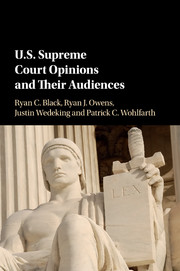Book contents
- Frontmatter
- Dedication
- Contents
- Acknowledgement
- 1 Introduction
- 2 A theory: using opinion clarity to enhance compliance and manage public support
- 3 Estimating the clarity of Supreme Court opinions
- 4 Supreme Court opinions and federal circuit courts
- 5 Supreme Court opinions and federal agency implementors
- 6 Supreme Court opinions and the states
- 7 Supreme Court opinions and the secondary population
- 8 Establishing compliance as a function of clarity
- 9 Conclusion
- References
- Index
4 - Supreme Court opinions and federal circuit courts
Published online by Cambridge University Press: 05 February 2016
- Frontmatter
- Dedication
- Contents
- Acknowledgement
- 1 Introduction
- 2 A theory: using opinion clarity to enhance compliance and manage public support
- 3 Estimating the clarity of Supreme Court opinions
- 4 Supreme Court opinions and federal circuit courts
- 5 Supreme Court opinions and federal agency implementors
- 6 Supreme Court opinions and the states
- 7 Supreme Court opinions and the secondary population
- 8 Establishing compliance as a function of clarity
- 9 Conclusion
- References
- Index
Summary
Supreme Court justices have two primary goals while managing the federal judicial hierarchy. The first is a legal goal. Justices seek to ensure lower courts apply federal law uniformly (Lindquist and Klein 2006; Perry 1991). The second is a policy goal. Justices want to ensure lower court judges faithfully apply the policies the High Court creates (Murphy 1964). The problem, however, is lower court judges sometimes have their own goals that may not coincide with the Supreme Court's – or with the goals of judges in other circuits. As we stated in the book's introduction, Ninth Circuit Court of Appeals Judge Stephen Reinhardt once claimed to “follow the law the way it used to be, before the Supreme Court began rolling back a lot of people's rights” (Baum 2006). Defiance, indeed. At the same time, it is not uncommon for lower court judges to split on how to interpret federal law. For example, on July 22, 2014, the Circuit Court of Appeals for the District of Columbia decided Halbig v. Burwell (2014), holding the Affordable Care Act unambiguously restricted IRS subsidies to insurance purchased only on exchanges “established by the State.” That same day, however, the Fourth Circuit Court of Appeals decided the language of the Act was broad enough to allow the IRS to subsidize insurance purchased on exchanges created by the federal government. The conflict between these circuits was huge, with the D.C. Circuit's interpretation threatening effectively to wipe out the controversial law.
In this chapter, we consider how the preferences of lower court judges influence Supreme Court justices’ goals and opinions; that is, whether lower court judges influence the clarity of Supreme Court opinions. We begin with a discussion about justices’ legal motivations and how clarity can help them achieve those goals. Next, we discuss how clarity can help justices achieve their ideological goals. After discussing these two goals, and how they relate to justices’ opinions, we examine how ideological conflict among lower courts leads justices to write clearer opinions, and how ideological distance between the two levels of courts influences Supreme Court opinion clarity.
A theory of opinion clarity and federal circuit courts
For those readers just joining us, our broad theory (as laid out in Chapter 2) is that justices alter the clarity of their opinions to enhance the likelihood of compliance with their decisions and to manage public support for the Court.
- Type
- Chapter
- Information
- US Supreme Court Opinions and their Audiences , pp. 60 - 79Publisher: Cambridge University PressPrint publication year: 2016
- 2
- Cited by



